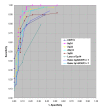Analysis of genetic copy number changes in cervical disease progression
- PMID: 20712890
- PMCID: PMC2936324
- DOI: 10.1186/1471-2407-10-432
Analysis of genetic copy number changes in cervical disease progression
Abstract
Background: Cervical dysplasia and tumorigenesis have been linked with numerous chromosomal aberrations. The goal of this study was to evaluate 35 genomic regions associated with cervical disease and to select those which were found to have the highest frequency of aberration for use as probes in fluorescent in-situ hybridization.
Methods: The frequency of gains and losses using fluorescence in-situ hybridization were assessed in these 35 regions on 30 paraffin-embedded cervical biopsy specimens. Based on this assessment, 6 candidate fluorescently labeled probes (8q24, Xp22, 20q13, 3p14, 3q26, CEP15) were selected for additional testing on a set of 106 cervical biopsy specimens diagnosed as Normal, CIN1, CIN2, CIN3, and SCC. The data were analyzed on the basis of signal mean, % change of signal mean between histological categories, and % positivity.
Results: The study revealed that the chromosomal regions with the highest frequency of copy number gains and highest combined sensitivity and specificity in high-grade cervical disease were 8q24 and 3q26. The cytological application of these two probes was then evaluated on 118 ThinPrep samples diagnosed as Normal, ASCUS, LSIL, HSIL and Cancer to determine utility as a tool for less invasive screening. Using gains of either 8q24 or 3q26 as a positivity criterion yielded specificity (Normal +LSIL+ASCUS) of 81.0% and sensitivity (HSIL+Cancer) of 92.3% based on a threshold of 4 positive cells.
Conclusions: The application of a FISH assay comprised of chromosomal probes 8q24 and 3q26 to cervical cytology specimens confirms the positive correlation between increasing dysplasia and copy gains and shows promise as a marker in cervical disease progression.
Figures




Similar articles
-
Chromosomal gains measured in cytology samples from women with abnormal cervical cancer screening results.Gynecol Oncol. 2013 Sep;130(3):595-600. doi: 10.1016/j.ygyno.2013.06.005. Epub 2013 Jun 13. Gynecol Oncol. 2013. PMID: 23769811 Free PMC article.
-
Genomic amplification patterns of human telomerase RNA gene and C-MYC in liquid-based cytological specimens used for the detection of high-grade cervical intraepithelial neoplasia.Diagn Pathol. 2012 Apr 13;7:40. doi: 10.1186/1746-1596-7-40. Diagn Pathol. 2012. PMID: 22500694 Free PMC article.
-
Gain of 3q26: a genetic marker in low-grade squamous intraepithelial lesions (LSIL) of the uterine cervix.Gynecol Oncol. 2009 Jul;114(1):80-3. doi: 10.1016/j.ygyno.2009.03.031. Epub 2009 Apr 25. Gynecol Oncol. 2009. PMID: 19394683
-
Gain of Chromosomal Region 3q26 as a Prognostic Biomarker for High-Grade Cervical Intraepithelial Neoplasia: Literature Overview and Pilot Study.Pathol Oncol Res. 2019 Apr;25(2):549-557. doi: 10.1007/s12253-018-0480-y. Epub 2018 Oct 25. Pathol Oncol Res. 2019. PMID: 30361910 Free PMC article. Review.
-
DBD-FISH Using Specific Chromosomal Region Probes for the Study of Cervical Carcinoma Progression.Methods Mol Biol. 2024;2784:271-284. doi: 10.1007/978-1-0716-3766-1_18. Methods Mol Biol. 2024. PMID: 38502492 Review.
Cited by
-
c-myc copy number gain is a powerful prognosticator of disease outcome in cervical dysplasia.Oncotarget. 2015 Jan 20;6(2):825-35. doi: 10.18632/oncotarget.2706. Oncotarget. 2015. PMID: 25596731 Free PMC article.
-
An Optimization-Driven Analysis Pipeline to Uncover Biomarkers and Signaling Paths: Cervix Cancer.Microarrays (Basel). 2015 Jun;4(2):287-310. doi: 10.3390/microarrays4020287. Microarrays (Basel). 2015. PMID: 26388997 Free PMC article.
-
Chromosomal gains measured in cytology samples from women with abnormal cervical cancer screening results.Gynecol Oncol. 2013 Sep;130(3):595-600. doi: 10.1016/j.ygyno.2013.06.005. Epub 2013 Jun 13. Gynecol Oncol. 2013. PMID: 23769811 Free PMC article.
-
In situ phenotypic and karyotypic co-detection of aneuploid TCs and TECs in cytological specimens with abnormal cervical screening results.BMC Cancer. 2025 May 26;25(1):945. doi: 10.1186/s12885-025-14346-y. BMC Cancer. 2025. PMID: 40420028 Free PMC article.
-
Genomic amplification patterns of human telomerase RNA gene and C-MYC in liquid-based cytological specimens used for the detection of high-grade cervical intraepithelial neoplasia.Diagn Pathol. 2012 Apr 13;7:40. doi: 10.1186/1746-1596-7-40. Diagn Pathol. 2012. PMID: 22500694 Free PMC article.
References
-
- American Cancer Society. What are the key statistics about Cervical Cancer? American Cancer Society. 2007.
-
- Walboomers JM, Jacobs MV, Manos MM, Bosch FX, Kummer JA, Shah KV, Snijders PJ, Peto J, Meijer CJ, Munoz N. Human papillomavirus is a necessary cause of invasive cervical cancer worldwide. J Pathol. 1999;189(1):12–19. doi: 10.1002/(SICI)1096-9896(199909)189:1<12::AID-PATH431>3.0.CO;2-F. - DOI - PubMed
-
- The Atypical Squamous Cells of Undetermined Significance/Low-Grade Squamous Intraepithelial Lesions Triage Study (ALTS) Group. Human papillomavirus testing for triage of women with cytologic evidence of low-grade squamous intraepithelial lesions: baseline data from a randomized trial. J Natl Cancer Inst. 2000;92(5):397–402. doi: 10.1093/jnci/92.5.397. - DOI - PubMed
MeSH terms
LinkOut - more resources
Full Text Sources
Other Literature Sources
Medical
Research Materials

